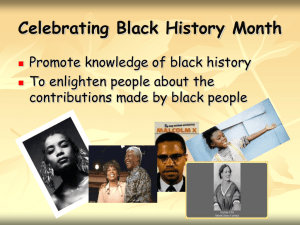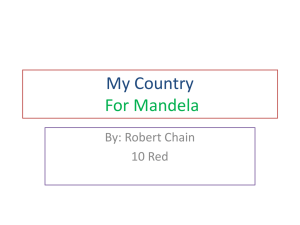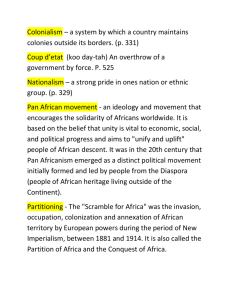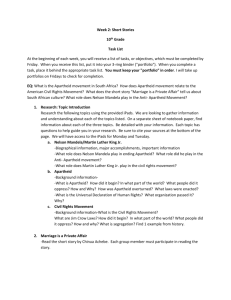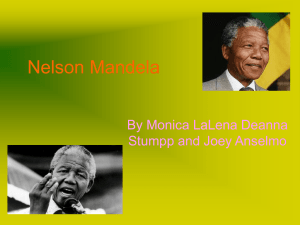File - Tennessee Geographic Alliance
advertisement
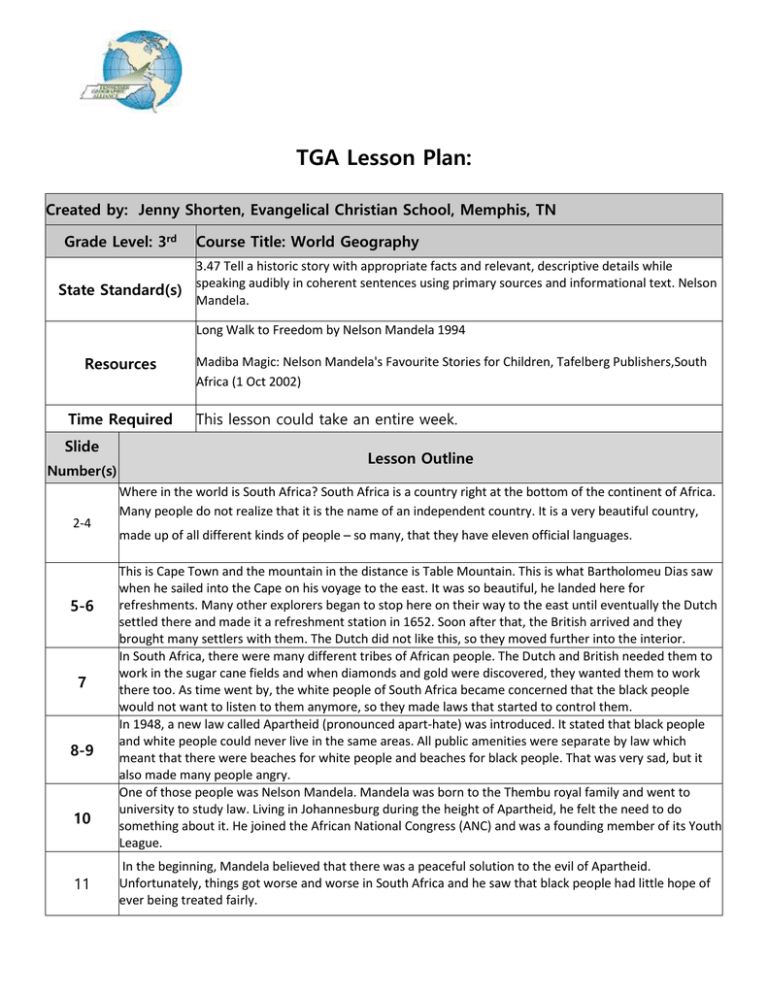
TGA Lesson Plan: Created by: Jenny Shorten, Evangelical Christian School, Memphis, TN Grade Level: 3rd Course Title: World Geography 3.47 Tell a historic story with appropriate facts and relevant, descriptive details while speaking audibly in coherent sentences using primary sources and informational text. Nelson State Standard(s) Mandela. Long Walk to Freedom by Nelson Mandela 1994 Resources Time Required Slide Number(s) 2-4 5-6 7 8-9 10 11 Madiba Magic: Nelson Mandela's Favourite Stories for Children, Tafelberg Publishers,South Africa (1 Oct 2002) This lesson could take an entire week. Lesson Outline Where in the world is South Africa? South Africa is a country right at the bottom of the continent of Africa. Many people do not realize that it is the name of an independent country. It is a very beautiful country, made up of all different kinds of people – so many, that they have eleven official languages. This is Cape Town and the mountain in the distance is Table Mountain. This is what Bartholomeu Dias saw when he sailed into the Cape on his voyage to the east. It was so beautiful, he landed here for refreshments. Many other explorers began to stop here on their way to the east until eventually the Dutch settled there and made it a refreshment station in 1652. Soon after that, the British arrived and they brought many settlers with them. The Dutch did not like this, so they moved further into the interior. In South Africa, there were many different tribes of African people. The Dutch and British needed them to work in the sugar cane fields and when diamonds and gold were discovered, they wanted them to work there too. As time went by, the white people of South Africa became concerned that the black people would not want to listen to them anymore, so they made laws that started to control them. In 1948, a new law called Apartheid (pronounced apart-hate) was introduced. It stated that black people and white people could never live in the same areas. All public amenities were separate by law which meant that there were beaches for white people and beaches for black people. That was very sad, but it also made many people angry. One of those people was Nelson Mandela. Mandela was born to the Thembu royal family and went to university to study law. Living in Johannesburg during the height of Apartheid, he felt the need to do something about it. He joined the African National Congress (ANC) and was a founding member of its Youth League. In the beginning, Mandela believed that there was a peaceful solution to the evil of Apartheid. Unfortunately, things got worse and worse in South Africa and he saw that black people had little hope of ever being treated fairly. 12-15 16 17 There was a great deal of violence in South Africa as people started to protest against Apartheid. Mandela joined the Defiance Campaign and he co-founded the militant Umkhonto we Sizwe (MK) in 1961, leading a sabotage campaign against the apartheid government. Stop for a moment and explain what defiance and sabotage mean. In 1962, he was arrested, convicted of conspiracy to overthrow the state, and sentenced to life imprisonment in the Rivonia Trial. Listen to the song, “Free Nelson Mandela.” It was banned in South Africa by the Apartheid government, so it became the song of the ANC. https://www.youtube.com/watch?v=2_G7vzJwcYM Divide the class in half. The students on the left must say what they think about the picture. The students on the right must say what they feel about the picture. Have a class discussion. Extension There was so much sadness in South Africa. Do you think there was hope? How do you think this story ends Exercise well? 18 19- 20 Exercise 21 There was definitely hope! Mandela was supposed to be in jail for life, but after 27 years, he was set free. Whilst he was in jail, he realized that violence was not the answer to bringing about change. He started to think about a peaceful solution. Soon after his release, he became the first democratically elected black president in South Africa. He set about changing all the bad things that had happened in South Africa during Apartheid, but he did it with love. He had forgiveness in his heart for all the terrible things that had happened. (When African people raise their hands in a fist, it means “amandla” which means power in Zulu.) Ask the students what forgiveness means. Have they ever had a time in their lives when they had to forgive someone? How did it feel? Watch the movie Invictus. Here is the official trailer: https://www.youtube.com/watch?v=RZY8c_a_dlQ You will have to explain to the students what rugby is. It is a sport similar to American football, but the players do not wear helmets or shoulder pads. It was traditionally a sport that only white people played. Black people played soccer. In the movie, Mandela decides to use the game of rugby to unite the country during the World Cup. He is successful and the story ends with a country that is far more united than ever before. Students could research rugby and compare and contrast it to football. In1993 Mandela won the Nobel Peace Prize, the US Presidential Medal of Freedom, and the Soviet Order of Lenin. He is held in deep respect within South Africa, where he is often referred to by his Xhosa clan name, Madiba, or as Tata ("Father"); he is often described as "the father of the nation". He died December 2013, aged 95. He died a happy man, having accomplished freedom for South Africa. Write a story about Nelson Mandela’s life using all the information that you have learned. Be sure to Extension Exercise explain where he lived and what Apartheid is. Describe what life was like in South Africa. Discuss how Mandela was able to free the country from Apartheid.

